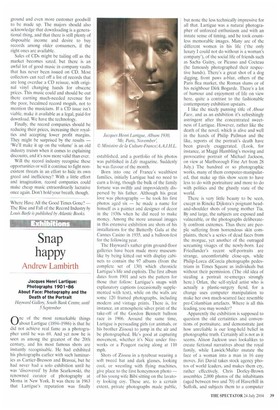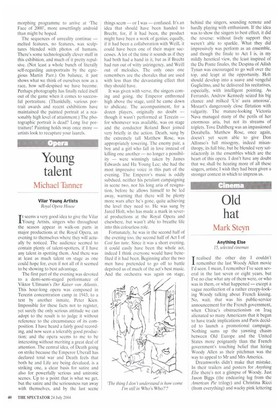Snap happy
Andrew Lambirth
Jacques Henri Lartique: Photographs 1901-86 About Face: Photography and the Death of the Portrait
Hayward Gallay, South Bank Centre, until 5 September ("Nine of the most remarkable things V about Lartigue (1894-1986) is that he did not achieve real fame as a photographer until he was 69. And yet now he is seen as among the greatest of the 20th century, and his most famous shots are instantly recognisable. He had exhibited his photographs earlier with such luminaries as Cartier-Bresson and Brassai, but he had never had a solo exhibition until he was 'discovered' by John Szarkowski, the renowned curator of photography at Moma in New York. It was there in 1963 that Lartigue's reputation was finally established, and a portfolio of his photos was published in Life magazine. Suddenly he was flavour of the month.
Born into one of France's wealthiest families, initially Lartigue had no need to earn a living, though the bulk of the family fortune was swiftly and improvidently dispersed by his father. Although his great love was photography — he took his first photos aged six — he made a name for himself as a painter and designer of decor in the 1930s when he did need to make money. Among the more unusual images in this extensive exhibition are shots of his installations for the Butterfly Gala at the Cannes Casino in 1935, and a balloon-fest for the following year.
The Hayward's rather grim ground-floor galleries have been made more museumlike by being kitted out with display cabinets to contain the 97 albums (from the complete set of 130) which chronicle Lartigue's life and exploits. The first album dates from 1901 and sets the pattern for those that follow: Lartigue's snaps with explanatory captions (occasionally supplemented with text), while on the walls are some 120 framed photographs, including modern and vintage prints. There is, for instance, an atmospheric silver print of the take-off of the Gordon Bennett balloon race in 1906. Around the same time, Lartigue is persuading girls (or animals, or his brother Zissou) to jump in the air and be photographed. He's good at capturing movement, whether it's Nice under fireworks or a Peugeot racing along at 110 mph.
Shots of Zissou in a tyreboat wearing a soft tweed hat and dark glasses, looking cool, or wrestling with flying machines, give place to the first honeymoon photo — of his young wife Bibi sitting on the lavatory looking coy. These are, to a certain extent, private photographs made public, but none the less technically impressive for all that. Lartigue was a natural photographer of unforced enthusiasm and with an innate sense of timing, and he took countless memorable images. Many are of the different women in his life (the only luxury I could not do without is a woman's company'), of the social life of friends such as Sacha Guitty, or Picasso and Cocteau (he famously photographed their respective hands). There's a great shot of a dog digging, front paws a-blur, others of the Paris flea market, the Roman slums or of his neighbour Dirk Bogarde. There's a lot of humour and enjoyment of life on view here, quite a contrast to the fashionable contemporary exhibition upstairs.
I like the nicely punning title of About Face, and as an exhibition it's refreshingly astringent after the concentrated sweetness of Lartigue. However, rather like the death of the novel, which is alive and well in the hands of Philip Pullman and the like, reports of the portrait's death have been gravely exaggerated. (Look, for instance, at Maggi Hambling's moving and provocative portrait of Michael Jackson, on view at Marlborough Fine Art from 28 July.) The hundred or so photographic works, many of them computer-manipulated, that make up this show seem to have less to do with portraiture and more to do with politics and the ghastly state of the world.
There is very little beauty to be seen, except in Rineke Dijkstra's poignant headand-shoulder shots of young mother Tia. By and large, the subjects are exposed and vulnerable, or the photographs deliberately confront extremes. Thus there are people suffering from horrendous skin complaints, there's a series of dead faces from the morgue, yet another of the outraged screaming visages of the newly-born. Lee Friedlander's recent self-portraits are strange, uncomfortable close-ups, while Philip-Lorca diCorcia photographs pedestrians in Times Square as individuals but without their permission. (The old idea of stealing a portrait re-emerges strongly here.) OrIan, the self-styled artist who is actually a plastic-surgery fiend, for a change uses computer manipulation to make her own much-scarred face resemble pre-Columbian artefacts. Where is all this leading, you may wonder?
Apparently the exhibition is supposed to question the old certainties and conventions of portraiture, and demonstrate just how unreliable is our long-held belief in photographic truth. Certainly all is not as it seems. Alison Jackson uses lookalikes to create fictional narratives about the royal family, while Lawick/Muller mutate the face of a woman into a man in 16 easy moves. Jiri David takes stock agency photos of world leaders, and makes them cry, rather effectively. Chris Dorley-Brown assembles 2,000 photos of the inhabitants (aged between two and 70) of Haverhill in Suffolk, and subjects them to a computer morphing programme to arrive at 'The Face of 2000% more unsettlingly android than might be hoped.
The sequences of unreality continue — melted features, no features, wax sculptures blended with photos of humans. There's some technologically clever stuff in this exhibition, and much of it pretty repulsive. (Not least a whole bunch of literally self-regarding autoportraits by the egregious Martin Parr.) On balance, it just shows what we think of ourselves now as a race, how self-despised we have become. Perhaps photography has finally ruled itself out of the game when it comes to successful portraiture. (Thankfully, various portrait awards and recent exhibitions have maintained the painted portrait at a reasonably high level of attainment.) The photographic portrait is dead? Long live portraiture? Painting holds sway once more — artists look to recapture your laurels.



























































 Previous page
Previous page